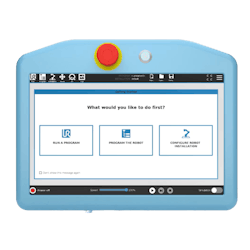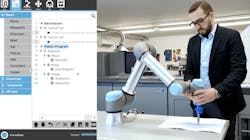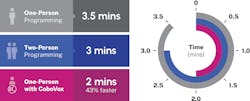Benefits of Voice-Enabled Applications for Cobot Programming
In recent years, technological innovations in cobot programming have been instrumental in widening the accessibility of these robotics systems for manufacturers. Intuitive teach pendant interfaces and hand-guiding capabilities are making cobots more user-friendly, reducing the need for specialized robotics knowledge.
This democratization of cobot programming approaches is transforming the manufacturing landscape, enabling businesses of all sizes to adopt cobots to automate a wider range of tasks.
But what if we could take cobot programming simplicity even further with voice?
Voice-Enabled Applications: A New Era in Cobot Programming
Solutions are currently emerging in the market that leverage human voice to facilitate cobot programming. One of the brands working to achieve this is Konica Minolta. Its new CoboVox application (UR+Partner) allows operators without prior knowledge of robotics to program a Universal Robot cobot by recording positions and parameters. In addition, the cobot can prompt the operator with questions and confirm when commands are completed for instantaneous feedback.
To fully appreciate the potential of voice-enabled programming, it’s important to keep in mind how cobots are typically taught programs today.
Operators use the teach pendant’s graphical interface to manually enter commands and sequences that the cobot must execute.
To further simplify cobot programming, many cobots have hand-guiding capabilities, enabling operators to physically guide the cobot's arm to the right positions. These positions can then be saved within the teach pendant for future reference. Nonetheless, this process can become somewhat clunky as operators are required to have both hands on the cobot while simultaneously inputting instructions in the teach pendant.
With voice-enabled cobot programming solutions, the operator does not need to repeatedly alternate between the command being taught and the teach pendant. Inevitably, this ease of use and optimized work method can significantly shorten programming times.
This is how voice-enabled cobot programming could work. The operator would move the cobot to a home position manually and then tell the cobot to save it, by saying: “Save this position as Home Position.” Once saved, the cobot would ask what the next step is, by answering: “Done. What is next?” The operator would manually move the cobot arm to the next position and tell the cobot to save it as Waypoint 1, for example, simply by giving the instruction: “Save this position as Waypoint 1.” This workflow would continue until the entire program has been completed and saved in the teach pendant.
You can see a demo of voice-enabled cobot programming in action on this website.
Cobots are already helping many businesses in a wide range of sectors overcome the issues associated with a scarcity of experienced robotics experts. Voice-enabled cobot programming makes it even easier to upskill operators to work with cobots without the time-gouging back and forth between the cobot and teach pendant.
Voice commands are even easier than navigating a user interface, no matter how simple it is. With a direct response from the application, operators gain the confidence of knowing that the commands are understood and carried out, reducing errors.
Real-Life Demonstration of Faster Cobot Programming
The CoboVox team set out to prove how faster cobot programming could be achieved with a voice-enabled application. They set up a test program for the demo, which involved a welding procedure of a 32 ft2 (3 m2) path with 4 waypoints. The test program included initiation and calibration of the tool, the programming of the path using waypoints, and re-execution of the program to validate it.Two main setups were made: one with a single operator and one with two operators.
- A Universal Robots cobot was programmed the traditional way, with its “freedrive” mode and manual inputting of commands in the teach pendant, and with CoboVox.
- In traditional cobot programming, having a second operator often improves efficiency, as one person is responsible for operating the teach pendant and recording the waypoints, while the second operator physically handles the robot.
- In contrast, with CoboVox, only one operator was required to both manipulate the cobot and input commands verbally, eliminating the need for a second person.
The results were compelling. Traditional cobot programming with one operator took 3.5 minutes, while two operators took 3 minutes. One operator with voice-enabled programming took 2 minutes, a 43% reduction in programming time.
While this was just one demonstration, productivity levels can quickly increase, especially in production environments with many different parts to manufacture.
Examples of Where Voice-Enabled Commands Could Accelerate Cobot Programming
Part or product inspection teams could use simple voice commands to explain the specifications without any manual input with the teach pendant. Battery inspections, where an operator would normally manually enter the precise number of rows and columns of each battery to be inspected, can take a lot of time. But with voice-enabled programming, the operator would just have to say them.
Welding is an area very much conducive to voice-enabled cobot programming too. Imagine a welder setting parameters, such as time and temperature, by just talking. The teaching process would also be easier by moving the cobot to its positions, focusing on the weld joints, without going back and forth with the teach pendant. The productivity gains could be substantial because some welding jobs can change regularly.
A Promising Future for Voice-Enabled Cobot Programming
We’re on the cusp of a whole new way to program and use cobot systems. By reducing the complexity of human-cobot interactions, products like CoboVox are lowering the barrier to entry for many companies that want to take advantage of robotics but also want to mitigate the challenges often encountered with conventional programming.
Bahadur Ibrahimov is the Lead Roboticist at Konica Minolta Business Solutions Europe GmbH.
About the Author

Bahadur Ibrahimov
Lead Roboticist, Konica Minolta Business Solutions Europe GmbH
Bahadur Ibrahimov is the Lead Roboticist at Konica Minolta Business Solutions Europe GmbH. He has had a multifaceted career and expert knowledge in Robotics research and innovation management.



